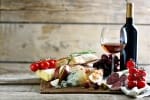Wine Gifts for the Holidays
[vc_row][/vc_row][vc_row][vc_column][vc_column_text]
Presence of Wine:
Mindful Gifts for Wine Lovers
THOUGHTS THIS TIME OF YEAR TURN NATURALLY — OR MAYBE RELUCTANTLY — TO GIFT GIVING. WHETHER YOU APPROACH THIS TASK WITH A SENSE OF MISSION, DREAD or excitement, here are some gift suggestions for friends, coworkers, clients, family or others you care about who like wine.
Wine Stuff
Accuse me of being a snob, but most wine — red wine especially — is more enjoyable when sipped from glasses that help make it visually appealing and also have a shape wide and high enough to safely swirl the wine and collect its aromas. (For sparkling wine, glasses should have tall, narrow flutes that reduce the surface area from which bubbles will escape. And for sweet wines, like Port or Sauternes, it’s traditional to use shorter, smaller-bowled glasses.)
Whether wine glasses have stems or not is a matter of personal preference. Either way, they should be clear, untinted and made ideally of crystal. Crystal helps to make them thinner and harder than regular glass. One popular brand, Riedel, sells a prodigious assortment of wine glasses, each shaped specifically for a different kind of wine. They’re quite expensive, however. A set of two will set you back $60 or more. It’s debatable whether the shape distinctions will make your favorite zinfandel or shiraz taste better — or worse if served in a glass designed for pinot noir or chardonnay.
Fortunately, there are high quality four and six glass sets available for $60 or less that will also serve the best wines in all their beauty and deliciousness. Two such manufacturers are Spiegelau and Schott-Zwiesel, among many others.
Most wine glass manufacturers also make decanters designed specifically to help wine quickly aerate. Some of the designs have wide, flat bottoms and narrow necks or exotic curvy shapes. So, if you give someone a decanter, splurge and buy a flexible bottlebrush to go with it.
CORKSCREWS:
Do you know someone who likes wine and owns a winged corkscrew? That’s the odd contraption with two handles that rise up as you twist the bottle-opener topped screw or “worm” into the cork. For heavens sake, give that person a better, easier tool for opening wine.
I use a simple waiter’s corkscrew or “sommelier knife.” They’re about the size and weight of a boy-scout pocket-knife. With practice, they’re fast and reliable to use. Inexpensive ones have stainless steel handles in many colors; more expensive models are available with wood or bone handles. The one you give should have a small pullout blade or foil cutter. Another important feature I like is when the stainless steel arm that braces against the lip of the bottle has two flexible parts so the cork can be leveraged out in two easy steps instead of one longer, sometimes harder motion. Also a Teflon-coated worm twists into cork more smoothly than an uncoated one.
Manual screw-pull type corkscrews are also effective. But there are now battery-operated devices based on the same principle plus clever lever openers, like the Rabbit, which are great, though they cost more and take up more space. Yet another type of opener is the harder-to-find — but occasionally indispensable — butler’s friend or two-pronged cork puller. It’s small and inexpensive with two slightly curved prongs that store in a short sheath and are attached to a bottle opener shaped handle. It works by shimmying the prongs between the cork and bottleneck and pulling the cork out with a slow twisting motion. It’s especially handy for removing damaged, broken or fragile corks.
Aerators are mostly simple and relatively inexpensive devices through which to pour and expose wine to more air than when poured straight from the bottle. It’s an alternative to aerating by decanting or opening a bottle to “breathe” an hour or so before drinking.
WINE PRESERVERS include some simple, inexpensive devices like the VacuVin that suck air from an opened wine bottle through a specially made rubber stopper. Preservers also include more costly gadgets that displace air in bottles with nitrogen or argon gas to preserve remaining wine for days, weeks, or even months. The Coravin device, which costs over $200, makes it possible to pour a small taste or a glass or two of wine by inserting a hypodermic-like needle through the cork and then preserving the rest for later without removing the cork. Other preservers, like WineKeeper, will enable your gift recipient to open, dispense and preserve multiple bottles of wine, providing an ever-ready choice of wines. The preservers housed in refrigerated cabinets you might have seen in a bar or restaurant can easily cost $2,000 or more depending on how many bottles they hold.
BOOKS AND MAGAZINES:
Drinking and savoring good wine, particularly with good food, can be reward enough. But reading about wine, I think, increases our appreciation and curiosity about wines we think we know as well as those we haven’t tried yet. For a pricey coffee table type book gift, standouts are the “World Atlas of Wine” by Hugh Johnson and Jancis Robinson and Jancis Robinson’s totally unique “Wine Grapes: A Complete Guide to 1,368 Vine Varieties and their Origins and Flavors.” Jancis Robinson, arguably the best of all living wine writers, is author of several other books, including “The Oxford Companion to Wine, 24-Hour Wine Expert,” and the terrific “How to Taste: A Guide to Enjoying Wine.” Hugh Johnson also writes the annually updated “Wine Pocket Book.” Among the most popular wine books are the two versions of “Wine Folly” by Madeline Puckette and Justin Hammack. One is subtitled The Essential Guide to Wine, and the newer larger version is modestly subtitled The Master Guide and includes very interesting food pairing guidelines. They’re excellent, easy-to-use reference books rather than cover-to-cover reads. Also popular is “The Wine Bible” by Karen McNeil, a nondenominational wine handbook.
There are numerous wine tasting course books. A standard is Kevin Zraly’s “Windows on the World Complete Wine Course,” which gets updated regularly. Zraly was the long-time sommelier and teacher at the New York World Trade Center’s famous restaurant and wine school. Another very differently organized book is Marnie Old’s “Wine: A Tasting Course.”
A wine magazine subscription is a great way to get a lot of information about wine in small doses, including wine ratings and articles about different wine regions, wineries, travel recommendations and so forth. Most popular is Wine Spectator followed by Wine Enthusiast magazine. These and other wine publishers, like Robert Parker Wine Advocate and Vinous operate paid as well as free website content.
Wines to Consider
If you’re thinking about giving someone a special bottle of wine for a holiday present, party or dinner, my number one suggestion is fine Champagne or top quality sparkling wine from California. Good bubbly is festive and enjoyed by nearly everyone. It drinks deliciously before and after meals, or with most foods, whether appetizers or main dishes. Quality Champagne will generally cost between $35 and $100 a bottle. Top California sparkling will cost between $20 and $60. Generally, the better — and usually more costly — the sparkling wine, the finer, more numerous, and more long-lasting the bubbles will be.
There are many outstanding Champagnes made by literally dozens of producers. Most are labeled as non-vintage (or NV), having been produced using grapes grown in multiple years. Some producers I like are Nicolas Feuillatte, Perrier-Jouët, Piper- Heidsieck, Pol Roger, and Tattinger. For California sparkling wine, look for Domaine Carneros, Domaine Chandon, Gloria Ferrer, and Schramsburg as well as Argyle from Oregon. I suggest buying sparkling wine that says Brut (Dry) or Extra Dry on the label.
If you prefer giving red wine and don’t already have a particular one in mind, I suggest giving premium pinot noir from the outstanding 2014-2016 vintages in Oregon and California’s Sonoma and Santa Lucia Highlands regions. The recipient can drink these wines now or set them aside for a few years. Some of my favorite producers are Cristom, Beaux Fréres, Bergström, Domaine Serene, Evening Land, Gary Farrell, Four Graces, Roar, Penner-Ash, Sojourn, and Ken Wright.
As for white wine, consider 2017 California chardonnay, ideally from Sonoma or the Central Coast. Unless you know the receiver prefers drier, crisper wines, I would look for creamy or buttery styles made in oak barrels. A handful of the many outstanding producers are Aubert, Brewer-Clifton, Failla, Hobbs, Lewis, Patz & Hall, Ramey, Roar, Sojourn, Sonoma-Loeb, and Walt.
Happy Holidays!
[/vc_column_text][/vc_column][/vc_row]







